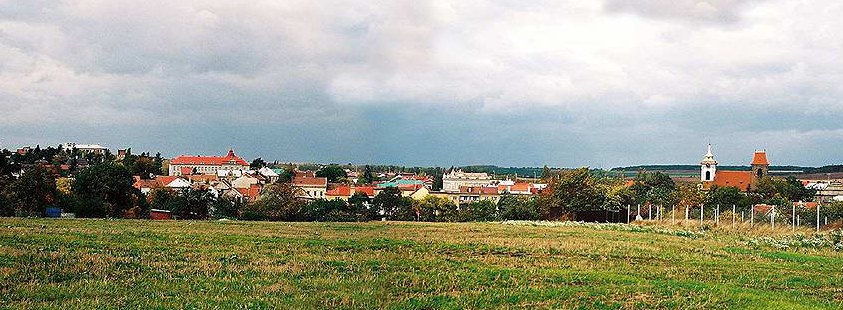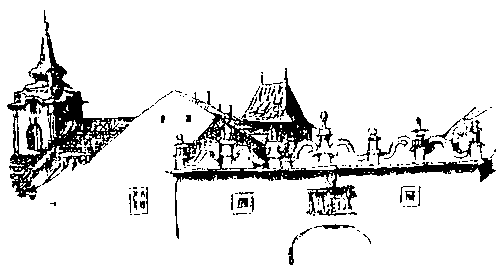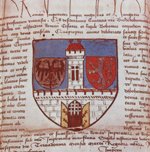Český Brod is lying east of Prague at the edge of the middle Elbe Basin and appearing headland of the Middle-Bohemian Highlands. Český Brod, proclaimed zone of historical monuments in 1990, is counted among the oldest Czech towns and also contributed to their development. The town Český Brod was probably founded by Prague's bishop Jan I. (1134 - 1139) at one of the most important land paths - Trstenická path, which had connected Prague with southern and eastern Europe.

Český Brod is lying east of Prague at the edge of the middle Elbe Basin and appearing headland of the Middle-Bohemian Highlands. Český Brod, proclaimed zone of historical monuments in 1990, is counted among the oldest Czech towns and also contributed to their development. The town Český Brod was probably founded by Prague's bishop Jan I. (1134 - 1139) at one of the most important land paths -Trstenická path, which had connected Prague with southern and eastern  Europe.Český Brod is lying east of Prague at the edge of the middle Elbe Basin and appearing headland of the Middle-Bohemian Highlands. Český Brod, proclaimed zone of historical monuments in 1990, is counted among the oldest Czech towns and also contributed to their development. The town Český Brod was probably founded by Prague's bishop Jan I. (1134 - 1139) at one of the most important land paths - Trstenická path, which had connected Prague with southern and eastern Europe. The new market settlement with a roman church of St. Gothard and a large market was established at a mild knoll above the ford over Šembera stream, where probably stayed also a bishop's custom - house. Probably in 1268 Prague's bishop Jan III. of Dražice proclaimed the local market settlement a town named Biskupský Brod (Broda Episcopalis, Bishop's ford) and probably at the same time conferred to the town also hereditary right and other town rights, above all right of fortification wall. In 1315, when Ronovs with 500 men-at-arms occupied Brod, the town had already been using altered name Český Brod (Broda Bohemicalis, Czech ford). This way should the town have been differentiated from Německý Brod (German ford) which was lying at the same path. In connection with development of town's local governments Český Brod as the first servitude town in Bohemia and Moravia built the town hall already before 1402. In the Hussite Revolution, before which the archbishop’s district of Český Brod expired, the town aimed political and administrative autonomy, Roman king Sigismund raised Český Brod to the Kingstown in 1437.
Europe.Český Brod is lying east of Prague at the edge of the middle Elbe Basin and appearing headland of the Middle-Bohemian Highlands. Český Brod, proclaimed zone of historical monuments in 1990, is counted among the oldest Czech towns and also contributed to their development. The town Český Brod was probably founded by Prague's bishop Jan I. (1134 - 1139) at one of the most important land paths - Trstenická path, which had connected Prague with southern and eastern Europe. The new market settlement with a roman church of St. Gothard and a large market was established at a mild knoll above the ford over Šembera stream, where probably stayed also a bishop's custom - house. Probably in 1268 Prague's bishop Jan III. of Dražice proclaimed the local market settlement a town named Biskupský Brod (Broda Episcopalis, Bishop's ford) and probably at the same time conferred to the town also hereditary right and other town rights, above all right of fortification wall. In 1315, when Ronovs with 500 men-at-arms occupied Brod, the town had already been using altered name Český Brod (Broda Bohemicalis, Czech ford). This way should the town have been differentiated from Německý Brod (German ford) which was lying at the same path. In connection with development of town's local governments Český Brod as the first servitude town in Bohemia and Moravia built the town hall already before 1402. In the Hussite Revolution, before which the archbishop’s district of Český Brod expired, the town aimed political and administrative autonomy, Roman king Sigismund raised Český Brod to the Kingstown in 1437.
Český Brod is an old gothic town with many historical building monuments. Cathedral of St. Gothard, late gothic belfry and the old town hall are counted among the most important ones. Houses of the town historical core usually have cellars, by which is possible to get into an underground corridor system. Part of this underground system has already been uncovered.
In new era is significant year 1960, when state authorities cancelled district of Český Brod an the region joined Kolín district.
Odkaz na podrobné kontaktní informace
Odkaz na online mapu, popřípadě emailový formulář.
Český Brod
 Český Brod is an ancient gothic town founded most probably by Prague’s bishop Jan I. in the 12th century on one of the country’s most important provincial paths, called Trstenická, linking the then market settlement of Prague with south-eastern Europe. Jan III of Dražice, the bishop of Prague, made the local market settlement a town – Biskupský Brod (Broda Episcopalis, Bishopford) in the middle of the 13th century. Owing to trading and travelling activities and extensive agriculture in the local vicinity, Biskupský Brod soon became a significant trading centre possessing both a market and guest houses. At the beginning of the 14th century the name of the town was changed to Český Brod (Broda Bohemicalis, Czechford), to be distinguished from the town of Německý Brod (Broda Germanica, Germanford), lying on the same commercial path.
Český Brod is an ancient gothic town founded most probably by Prague’s bishop Jan I. in the 12th century on one of the country’s most important provincial paths, called Trstenická, linking the then market settlement of Prague with south-eastern Europe. Jan III of Dražice, the bishop of Prague, made the local market settlement a town – Biskupský Brod (Broda Episcopalis, Bishopford) in the middle of the 13th century. Owing to trading and travelling activities and extensive agriculture in the local vicinity, Biskupský Brod soon became a significant trading centre possessing both a market and guest houses. At the beginning of the 14th century the name of the town was changed to Český Brod (Broda Bohemicalis, Czechford), to be distinguished from the town of Německý Brod (Broda Germanica, Germanford), lying on the same commercial path.
 The second largest town in the Kolín district in the flow of time…
The second largest town in the Kolín district in the flow of time…
Český Brod was founded as a market settlement, probably by Jan I. (1134 – 1139), the bishop of Prague, on one of the country’s most important provincial paths, Trstenická, linking Prague with south-eastern Europe. The new market settlement, with the Roman St.Gothard cathedral, and a spacious marketplace, arose on a gentle hillock elevated over the town and across the Šembera brook, where apparently the then bishop custom house also stood. The local ford of great importance, a day’s trip away from both Prague and Kouřim, surrounded by extensive marshlands, guaranteed the settlement not only permanent subsistence but also certain security, and gave it the name of Brod (a ford).



 Europe.Český Brod is lying east of Prague at the edge of the middle Elbe Basin and appearing headland of the Middle-Bohemian Highlands. Český Brod, proclaimed zone of historical monuments in 1990, is counted among the oldest Czech towns and also contributed to their development. The town Český Brod was probably founded by Prague's bishop Jan I. (1134 - 1139) at one of the most important land paths - Trstenická path, which had connected Prague with southern and eastern Europe. The new market settlement with a roman church of St. Gothard and a large market was established at a mild knoll above the ford over Šembera stream, where probably stayed also a bishop's custom - house. Probably in 1268 Prague's bishop Jan III. of Dražice proclaimed the local market settlement a town named Biskupský Brod (Broda Episcopalis, Bishop's ford) and probably at the same time conferred to the town also hereditary right and other town rights, above all right of fortification wall. In 1315, when Ronovs with 500 men-at-arms occupied Brod, the town had already been using altered name Český Brod (Broda Bohemicalis, Czech ford). This way should the town have been differentiated from Německý Brod (German ford) which was lying at the same path. In connection with development of town's local governments Český Brod as the first servitude town in Bohemia and Moravia built the town hall already before 1402. In the Hussite Revolution, before which the archbishop’s district of Český Brod expired, the town aimed political and administrative autonomy, Roman king Sigismund raised Český Brod to the Kingstown in 1437.
Europe.Český Brod is lying east of Prague at the edge of the middle Elbe Basin and appearing headland of the Middle-Bohemian Highlands. Český Brod, proclaimed zone of historical monuments in 1990, is counted among the oldest Czech towns and also contributed to their development. The town Český Brod was probably founded by Prague's bishop Jan I. (1134 - 1139) at one of the most important land paths - Trstenická path, which had connected Prague with southern and eastern Europe. The new market settlement with a roman church of St. Gothard and a large market was established at a mild knoll above the ford over Šembera stream, where probably stayed also a bishop's custom - house. Probably in 1268 Prague's bishop Jan III. of Dražice proclaimed the local market settlement a town named Biskupský Brod (Broda Episcopalis, Bishop's ford) and probably at the same time conferred to the town also hereditary right and other town rights, above all right of fortification wall. In 1315, when Ronovs with 500 men-at-arms occupied Brod, the town had already been using altered name Český Brod (Broda Bohemicalis, Czech ford). This way should the town have been differentiated from Německý Brod (German ford) which was lying at the same path. In connection with development of town's local governments Český Brod as the first servitude town in Bohemia and Moravia built the town hall already before 1402. In the Hussite Revolution, before which the archbishop’s district of Český Brod expired, the town aimed political and administrative autonomy, Roman king Sigismund raised Český Brod to the Kingstown in 1437. Český Brod is an ancient gothic town founded most probably by Prague’s bishop Jan I. in the 12th century on one of the country’s most important provincial paths, called Trstenická, linking the then market settlement of Prague with south-eastern Europe. Jan III of Dražice, the bishop of Prague, made the local market settlement a town – Biskupský Brod (Broda Episcopalis, Bishopford) in the middle of the 13th century. Owing to trading and travelling activities and extensive agriculture in the local vicinity, Biskupský Brod soon became a significant trading centre possessing both a market and guest houses. At the beginning of the 14th century the name of the town was changed to Český Brod (Broda Bohemicalis, Czechford), to be distinguished from the town of Německý Brod (Broda Germanica, Germanford), lying on the same commercial path.
Český Brod is an ancient gothic town founded most probably by Prague’s bishop Jan I. in the 12th century on one of the country’s most important provincial paths, called Trstenická, linking the then market settlement of Prague with south-eastern Europe. Jan III of Dražice, the bishop of Prague, made the local market settlement a town – Biskupský Brod (Broda Episcopalis, Bishopford) in the middle of the 13th century. Owing to trading and travelling activities and extensive agriculture in the local vicinity, Biskupský Brod soon became a significant trading centre possessing both a market and guest houses. At the beginning of the 14th century the name of the town was changed to Český Brod (Broda Bohemicalis, Czechford), to be distinguished from the town of Německý Brod (Broda Germanica, Germanford), lying on the same commercial path. The second largest town in the Kolín district in the flow of time…
The second largest town in the Kolín district in the flow of time…